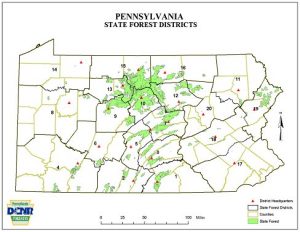By Rae Schnapp, Ph.D.
Our neighboring states are protecting their old forest areas. Why can’t Indiana? Senate Bill 420 would set aside a small portion, 10%, of Indiana’s state forestland to be off-limits to logging. Here’s an inside look as to how public forests are being managed outside of Indiana.
Pennsylvania
The Pennsylvania Bureau of Forestry has designated 231,516 acres just over 10% of PA’s 2.3 million acres of state forest as either Natural Areas or Wild Areas. Natural Areas are areas that have been set aside to provide locations for scientific observation of natural systems, to protect examples of typical unique plant and animal communities, and to protect outstanding examples of natural interest and beauty. Meanwhile, the management of wild areas will be aimed at preserving the wild or undeveloped character of the area for the public to see, use, and enjoy for such activities as hiking, hunting, and fishing. The Pennsylvania Legislature authorized the creation of these Natural Areas and Wild Areas and prescribed their management objective in 17 PA Code 27 in 1996. An additional 22% of state forest acreage is in designated Limited Resource zones, where commercial logging is prohibited due to severe topography and other factors. Further, the Pennsylvania State Forest Resource Management Plan sets the goal to maintain a minimum of 20% of state forestlands as potential or existing old-growth areas.
Wisconsin
Of the 436,153 acres of state forests managed by the Wisconsin DNR Division of Forestry, 61,353 acres (14.1%) are excluded from commercial timber harvests through various designations. Among these designated areas are ecological reference areas, which, according to the Wisconsin DNR’s 2010 State Lands Passive Management Report, provide baseline data that helps assess the long term impacts of active forest management. This same report calls for a broader definition of forest sustainability than the basic growth exceeds removals equation, one that takes into account biodiversity, wildlife, water quality, aesthetics, soil nutrients and stability, and other attributes of value. This report concludes that, in a state where the proportion of timber supply from state forests is comparable to Indiana (4% in Wisconsin vs. 4-7% in Indiana), the amount of land currently excluded from harvest on State lands is insignificant when compared to the total product output. The value of having some lands protected for the ecological and social benefits is proportionally higher. Public lands bear the responsibility of providing these forest amenities more so than other ownerships.
Maryland
In 1971, the Maryland Wildlands Act established a state system of legislatively designated areas to be preserved in their natural condition for present and future generations. To date, 29 State Wildlands have been established on state land, totaling nearly 44,000 acres. Of the approximately 200,000 acres in Maryland’s state forest system, nearly 22,000 acres (11%) are currently designated as State Wildlands and off-limits to timbering. An additional 9,106 acres of Wildlands have been proposed by MDNR in the state forests which would increase the acreage of Wildlands to 31,000 acres, or 15.5% of Maryland’s state forests.
Michigan
The Michigan Department of Natural Resources has designated 116,397acres of state forests off-limits to logging as Ecological Reference Areas (ERAs) to serve as models of ecological reference within the state, as well as recreation, research, and education. An additional 6,503 acres have been legally designated as Natural Areas, which offer unique opportunities for solitude or primitive and unconfined types of recreation, thus providing economic opportunities for local communities.
Ohio
In 1972, nearly 8,000 contiguous acres of the Shawnee State Forest were designated by the Legislature as a Wilderness Area. This area has been set aside by statute to allow natural forest succession and natural forest disturbances to occur without human influence and to provide an area that has outstanding opportunities for solitude and primitive recreation, among other goals.
Illinois
Illinois has 18,000 acres of state forest and does not conduct hardwood timber sales on state forest land. The state does sell timber from pine plantations.
Connecticut
11,168 acres (of 167,572 acres of state forest) are designated as Old Forest Management Sites. Old forest growth is an important ecological component of Connecticut’s state forests, selected to grow and evolve naturally to reach advanced stages of vegetative succession and develop with minimal or no human intervention. The goal is to establish or promote areas of advanced successional stages of forest growth comprising approximately ten (10) percent of Connecticut’s state forests.
View the preceding information with citations.
Please contact your state senator and ask them to support Senate Bill 420.

